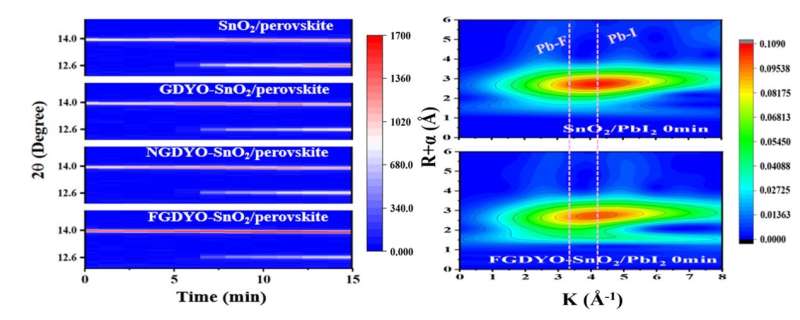This article has been reviewed according to Science X's editorial process and policies. Editors have highlighted the following attributes while ensuring the content's credibility:
fact-checked
peer-reviewed publication
trusted source
proofread
Researchers reveal mechanism of SnO2 electron transport layer modified by graphdiyne in perovskite solar cells

Prof. Sun Baoyun's group from the Institute of High Energy Physics (IHEP) of the Chinese Academy of Sciences recently used graphdiyne oxide (GDYO), fluorinated GDYO (FGDYO) and nitrogen-doped GDYO (NGDYO) to improve the SnO2 electron transport layer (ETL) in perovskite solar cells and revealed the relevant mechanism using synchrotron radiation technology. This study was published in Nano Today.
The researchers tracked the growth process of SnO2, PbI2 and perovskite using in situ XRD and the chemical bonds on the interface between ETL and the active layer using in situ XAFS. They found that the stronger interaction between the doped SnO2 and PbI2 inhibited PbI2 crystallization in perovskite layers and gave more opportunity for the PbI2 precursor to form perovskite, thus making perovskite crystallize better.
In addition, the researchers found different GDY-based materials to have different effects: NGDYO gave ETL the best conductivity and the most matched energy level, but the best perovskite crystallinity was induced by FGDYO–SnO2. Three GDY-based materials also had the same effects: SnO2 layers with GDY-based materials optimized the properties of the SnO2 layer itself and the interface between SnO2 and the perovskite layer, and then affected the growth of perovskite.
In situ XAFS, which captured key interface bonding information for the first time, laid the foundation for interface research using synchrotron radiation technology. At the same time, systematic research on the mechanism of additives is beneficial for providing the scientific basis for new ideas on improving the performance of perovskite devices.
More information: Dan Wang et al, SnO2 electron transport layer modified by F/N-doped graphdiyne and in situ XRD and in situ XAFS exploration on its effect on perovskite active layer, Nano Today (2023). DOI: 10.1016/j.nantod.2023.101852
Journal information: Nano Today
Provided by Chinese Academy of Sciences




















